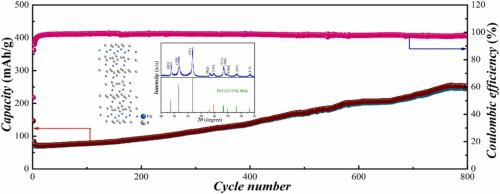Journal of Alloys and Compounds ( IF 5.8 ) Pub Date : 2024-01-10 , DOI: 10.1016/j.jallcom.2024.173484 Jing-Feng Hou , Jian-Fei Gao , Ling-Bin Kong

|
Lithium-ion capacitors (LICs), which combine great power and energy density, have become promising energy storage and have been well studied recently. Developing novel battery-type anode materials is the key to mitigating the kinetic mismatch between the anode and cathode electrodes. In this paper, niobium diboride (NbB2) nanoparticles are synthesized via a salt-templated method and proposed for the first time as the anodes for LICs. NbB2 is a layered two-dimensional material similar to graphite, which is favorable to the intercalation and deintercalation of Li+. The NbB2 with high conductivity delivers outstanding long cycling stability (254.1 mAh g−1 after 800 cycles at 0.1 A g−1) and great rate capability. Moreover, a high-performance LIC is assembled employing the prepared NbB2 as anode and commercialized activated carbon (AC) as cathode, which can display an energy density of 68.76 Wh kg−1, a power density of 7.02 kW kg−1, and a capacity retention ratio of 98% after 10,000 cycles. The work presents the great potential of transition metal borides as electrode materials and accelerates the development of LICs.
中文翻译:

硼化铌(NbB2):盐模板合成、赝电容电极和锂离子电容器应用
锂离子电容器(LIC)结合了巨大的功率和能量密度,已成为有前景的储能材料,并且最近得到了深入的研究。开发新型电池型负极材料是减轻阳极和阴极之间动力学失配的关键。在本文中,通过盐模板法合成了二硼化铌(NbB2)纳米粒子,并首次提出作为LICs的阳极。NbB2是一种类似于石墨的层状二维材料,有利于Li+。具有高电导率的NbB2具有出色的长循环稳定性(在0.1 A g-1-1)和出色的倍率性能。此外,采用制备的NbB 2作为阳极和商业活性炭(AC)作为阴极组装了高性能LIC-1,功率密度为7.02 kW kg-1, 10000次循环后容量保持率为98%。这项工作展现了过渡金属硼化物作为电极材料的巨大潜力,并加速了LIC的发展。

































 京公网安备 11010802027423号
京公网安备 11010802027423号